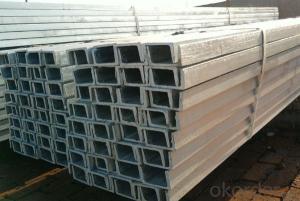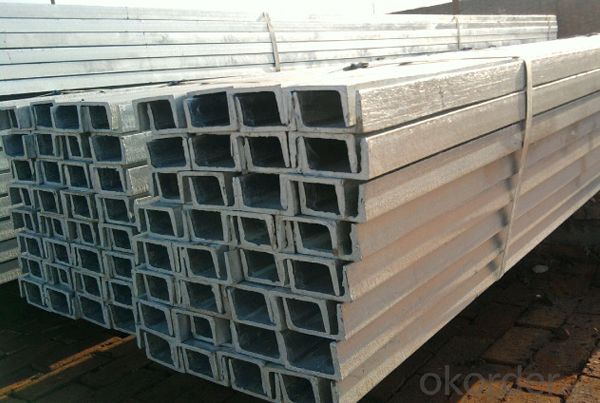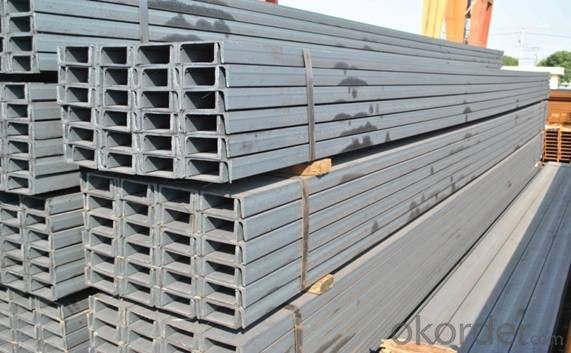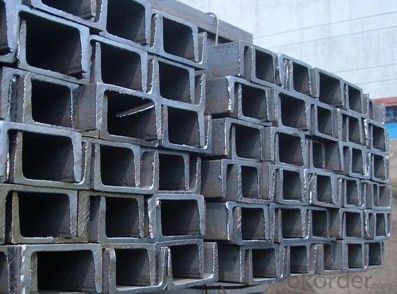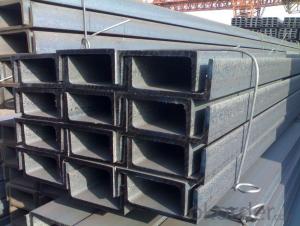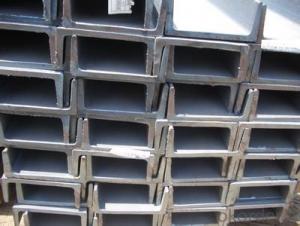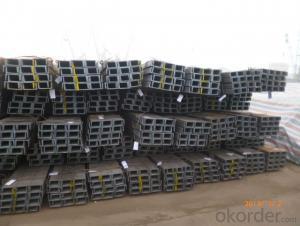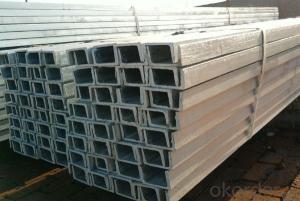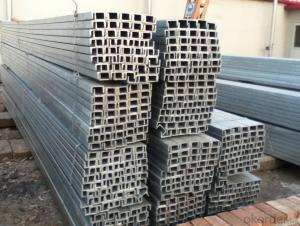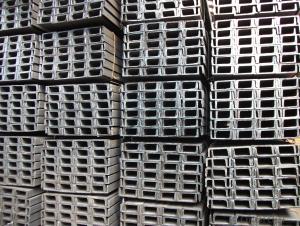Hot rolled high quality JIS U CHANNEL SS400
- Loading Port:
- Qingdao
- Payment Terms:
- TT OR LC
- Min Order Qty:
- 25 m.t.
- Supply Capability:
- 100000 m.t./month
OKorder Service Pledge
OKorder Financial Service
You Might Also Like
channel Details:
| Minimum Order Quantity: | Unit: | m.t. | Loading Port: | ||
| Supply Ability: | Payment Terms: | Package: | wire rod bundle |
Product Description:
Product Description:
Specifications of MS Channel:
1.We supply high quality MS Channel at reasonable price, including Chinese standard, Japanese standard and so on.
Standard | GB/JIS |
Material Grade | Q235,SS400 |
Technique: | Hot Rolled |
Sizes as per chinese standard: | 50*37*4.5mm - 300*89*11.5mm |
Sizes as per japanese standard: | 50*25*3mm – 200*80*7.5mm |
Length: | 6meter, 9meter, 12meter |
Note: 1.we are also competent to provide our customers other MS Channel based on other sizes according to customer’s requirements.
2. The length of our ms channel could be cut into other meters as per customer’s requirements. For example, the channel in 6meters could be cut into 5.8meters in order to be fit in the 20ft container.
2. The detailed sections of MS Channel as per GB standard.are shown in the table-1:
GB U CHANNEL | Standard | Sectional | Dimension |
| Mass: |
(mm) | (mm) | (mm) | (mm) | ||
50X37 | 50 | 37 | 4.50 | 7.0 | 5.438 |
63X40 | 63 | 40 | 4.80 | 7.5 | 6.634 |
80x43 | 80 | 43 | 5.00 | 8.0 | 8.045 |
100x48 | 100 | 48 | 5.30 | 8.5 | 10.007 |
120x53 | 120 | 53 | 5.50 | 9.0 | 12.059 |
140x58 | 140 | 58 | 6.00 | 9.5 | 14.535 |
140x60 | 140 | 60 | 8.00 | 9.5 | 16.733 |
160x63 | 160 | 63 | 6.50 | 10.0 | 17.240 |
160x65 | 160 | 65 | 8.50 | 10.0 | 19.752 |
180x68 | 180 | 68 | 7.00 | 10.5 | 20.174 |
180x70 | 180 | 70 | 9.00 | 10.5 | 23.000 |
200x73 | 200 | 73 | 7.00 | 11.0 | 22.637 |
200x75 | 200 | 75 | 9.00 | 11.0 | 25.777 |
220x77 | 220 | 77 | 7.00 | 11.5 | 24.999 |
220x79 | 220 | 79 | 9.00 | 11.5 | 28.453 |
250x78 | 250 | 78 | 7.00 | 12.0 | 27.410 |
250x80 | 250 | 80 | 9.00 | 12.0 | 31.335 |
250x82 | 250 | 82 | 11.00 | 12.0 | 35.260 |
280x82 | 280 | 82 | 7.50 | 12.5 | 31.427 |
280x84 | 280 | 84 | 9.50 | 12.5 | 35.823 |
280x86 | 280 | 86 | 11.50 | 12.5 | 40.219 |
300x85 | 300 | 85 | 7.50 | 13.5 | 34.463 |
300x87 | 300 | 87 | 9.50 | 13.5 | 39.173 |
300x89 | 300 | 89 | 11.50 | 13.5 | 43.883 |
Table-1
3. The chemical composition of HR Channel Steel according to Q235B is shown in Table-2.
Alloy No | Grade | Element(%) | ||||
C | Mn | S | P | Si | ||
Q235 | B | 0.12-0.20 | 0.3-0.7 | ≦0.045 | ≦0.045 | ≦0.3 |
Table-2
Note: we are able to present our customers relevant SGS test report for chemical composition of HR Channel Steel.
4. The mechanical property of HR Channel Steel according to Q235B is shown in Table-3-1 and Table-3-2
Alloy No | Grade | Yielding Strength Point(Mpa) | |||
Thickness(mm) | |||||
≦16 | >16-40 | >40-60 | >60-100 | ||
≧ | |||||
Q235 | B | 235 | 225 | 215 | 205 |
Table-3-1
Alloy No | Grade | Tensile Strength(Mpa) | Elongation After Fracture(%) | |||
Thickness(mm) | ||||||
≦16 | >16-40 | >40-60 | >60-100 | |||
≧ | ||||||
G235 | B | 375-500 | 26 | 25 | 24 | 23 |
Table-3-2
Note: we are able to present our customers relevant SGS test report for mechanical property of MS Channel as customer’s request.
Applications of MS Channel:
The MS Channel can be applied to construction of warehouses, workshops, sport stadiums and car parks etc.The hot rolled channel steel belongs to carbon structural steel which is applied to in the field of construction and machinery.In details, the hot rolled channel steel is usually used for arch-itechtural structure, and they could be welded in order to support or hang a vari-ety of facilities. They are also usually used in combination with I beam. Generally,the hot rolled channel steel we supply must possess perfect welding property, riveting property and mechanical property and so on.
Package & Delivery of MS Channel:
1.The hot rolled channel steel will be packed in bundle with steel wire at each end of every bundle and color marking in order to help the customer to recognize his goods more easily at sight.
2. And the hot rolled channel steel could be loaded into 20ft or 40ft container, or by bulk cargo.If the weight of each bundle reaches more than 3.5 mt, the loading by break bulk cargo should be choosed.When the weight of each bundle reaches less than 3mt, the loading by container should be choosed.
3.As for the transportaion from mill to loading port, the truck will be usually used. And the maximum quantity for each truck is 40mt.
4.All in all, we could do in accordance with customer's request
- Q: How do steel channels contribute to sustainable construction practices?
- Steel channels contribute to sustainable construction practices in several ways: 1. Durability: Steel channels are highly durable and have a long lifespan, which reduces the need for frequent replacements or repairs. This durability minimizes waste generation and reduces the consumption of materials over time. 2. Recyclability: Steel is one of the most recycled materials in the world. Steel channels can be easily recycled at the end of their lifespan, reducing the demand for new steel production and saving energy and resources. 3. Efficient use of materials: Steel channels can be designed to have optimal strength-to-weight ratios, allowing for the use of less material while maintaining structural integrity. This reduces the overall weight of the construction, leading to lower transportation and foundation costs. 4. Energy efficiency: Steel channels are often used in framing systems, which can help improve the energy efficiency of buildings. Steel framing allows for better insulation, reducing energy consumption for heating and cooling. Additionally, steel channels can be combined with other sustainable practices, such as using renewable energy sources or incorporating green building materials. 5. Resistance to natural disasters: Steel channels have high strength and resistance to fire, earthquakes, and extreme weather events. By using steel channels in construction, buildings can be designed to withstand these hazards, reducing the damage caused and increasing the safety and resilience of the structures. 6. Reduced construction waste: Steel channels can be prefabricated off-site, leading to reduced construction waste generation. Prefabrication allows for better quality control, minimizes on-site material waste, and reduces construction noise and disruption. Overall, steel channels contribute to sustainable construction practices by promoting durability, recyclability, efficient use of materials, energy efficiency, resistance to natural disasters, and reduced construction waste.
- Q: What are steel channels?
- Steel channels are structural components made from steel that are shaped like a "C" or a "U". They are commonly used in construction and engineering projects to provide support and stability. Steel channels are often used as beams or columns to carry heavy loads and distribute weight evenly. They can also be used as brackets or supports for various applications. These channels are durable, strong, and resistant to deformation, making them a popular choice in the construction industry. They are available in various sizes and thicknesses to accommodate different project requirements.
- Q: What are the different surface treatment processes for steel channels?
- Steel channels can undergo various surface treatment processes to enhance their durability, appearance, and corrosion resistance. Some common methods for treating steel channels include the following: 1. Galvanization: This technique involves immersing the steel channel in molten zinc to create a protective layer that resists corrosion. Galvanization effectively prevents rust formation and extends the lifespan of steel channels. 2. Powder coating: By electrostatically applying a dry powder to the steel channel and then heating it, a durable and smooth coating is formed. Powder coating offers exceptional resistance to corrosion, impact, and UV damage. Additionally, it provides a wide range of color options for aesthetic purposes. 3. Painting: Painting is a popular surface treatment process for steel channels. It entails applying a layer of paint to the surface, which acts as a barrier against moisture and other environmental factors, thereby preventing corrosion. Depending on specific requirements, different types of paints such as epoxy, polyurethane, or acrylic can be used. 4. Anodizing: Although primarily used for aluminum, anodizing can also be applied to steel channels. This process involves immersing the steel channel in an electrolytic bath and passing an electric current through it to create a protective oxide layer. Anodizing improves corrosion resistance and enhances the appearance of steel channels by creating a smooth and decorative finish. 5. Passivation: Passivation is a chemical process that eliminates iron contaminants from the surface of steel channels, enhancing their corrosion resistance. Typically, this process involves treating the steel channel with acid or other chemical agents to remove impurities that could potentially lead to corrosion. These surface treatment processes should be selected based on the specific requirements of the steel channel, including its intended use, environmental conditions, and desired appearance. Each process offers distinct advantages and significantly improves the performance and longevity of steel channels.
- Q: Can steel channels be used for equipment foundations?
- Indeed, equipment foundations can be built using steel channels. These channels are frequently employed in construction and engineering endeavors due to their formidable strength and durability. They possess the ability to furnish a stable and robust foundation for weighty machinery and equipment. Furthermore, steel channels can be readily fabricated and tailored to satisfy particular project prerequisites, rendering them a flexible option for equipment foundations. Nonetheless, it is crucial to take into account factors like load capacity, soil conditions, and seismic requirements during the design and construction stages of equipment foundations constructed with steel channels.
- Q: Can steel channels be used for framing?
- Yes, steel channels can be used for framing. Steel channels provide structural strength and stability, making them suitable for framing applications in various construction projects.
- Q: Can steel channels be used in the construction of retaining walls?
- Yes, steel channels can be used in the construction of retaining walls. Steel channels are often used as structural components in various construction projects due to their durability and strength. When used in retaining walls, steel channels can provide additional reinforcement and stability to the structure. They can be embedded into the ground as vertical or horizontal supports, helping to distribute the load and prevent soil erosion. Steel channels are also resistant to weathering and corrosion, making them suitable for long-term use in retaining walls. However, it is important to consider the specific design requirements and consult with a structural engineer to ensure the appropriate size, spacing, and placement of steel channels for the specific retaining wall project.
- Q: Can steel channels be used for column and beam connections?
- Steel channels are indeed suitable for column and beam connections. They are frequently employed in construction due to their ability to offer strength and support. By utilizing steel channels in column and beam connections, the load can be evenly distributed, contributing to the stability of the structure. Nevertheless, the appropriateness of steel channels for such connections may vary based on the particular demands and design of the project. Consulting a structural engineer or a knowledgeable professional in the field is crucial to ascertain the suitable materials and connections for a specific undertaking.
- Q: Can steel channels be used in the automotive manufacturing industry?
- Indeed, the automotive manufacturing industry can make use of steel channels. Given their strength, durability, and versatility, steel channels often serve as structural components in this sector. They find extensive application in chassis frames, suspension systems, and body structures. With exceptional load-bearing capabilities, steel channels can endure the demanding requirements of the automotive industry. Moreover, their ease of fabrication and welding renders them a favored option among automotive manufacturers.
- Q: What are the different cross-sectional shapes of steel channels?
- Steel channels are structural components that come in various cross-sectional shapes and are commonly used. The different shapes of steel channels include C channels, U channels, and Z channels. C channels, also referred to as C-sections or C beams, have a distinctive profile in the shape of a C. They have a wide top and a narrow bottom, with two flanges that extend outward at a right angle from the web. C channels are used in construction and engineering applications to provide structural support and stability. U channels, also known as U-sections or U beams, have a profile in the shape of a U. They have parallel flanges that connect through a web in the center. U channels are widely utilized in manufacturing and industrial applications, specifically in conveyor systems, support structures, and framing. Z channels, also referred to as Z-sections or Z beams, have a profile in the shape of a Z. They have a vertical web with two flanges that are angled outward in opposite directions. Z channels are frequently employed in construction and architectural applications to provide strength and stability in various structural elements such as roof purlins and wall studs. Each of these cross-sectional shapes possesses distinct characteristics and advantages, which make them suitable for different applications. The selection of a steel channel shape depends on factors such as load-bearing requirements, structural design, and specific project needs.
- Q: What are the safety considerations when working with steel channels?
- When working with steel channels, there are several safety considerations that need to be taken into account. First and foremost, it is important to wear appropriate personal protective equipment (PPE) such as safety glasses, gloves, and steel-toed boots. This will help protect against potential hazards such as sharp edges, flying debris, and falling objects. It is also crucial to inspect the steel channels for any defects or damage before working with them. This includes checking for cracks, bends, or corrosion that could compromise the structural integrity of the channels. If any issues are found, they should be addressed or the channels should be replaced to ensure a safe working environment. When handling steel channels, it is important to use proper lifting techniques and equipment to prevent strain or injury. Steel channels can be heavy and awkward to maneuver, so utilizing lifting aids such as cranes, hoists, or forklifts can greatly reduce the risk of accidents or musculoskeletal injuries. Another safety consideration is to ensure proper storage and stacking of steel channels. They should be stored in a designated area that is clear of obstructions and away from other materials that may pose a risk of falling or causing damage. Stacking should be done in a stable and secure manner, with heavier or larger channels placed at the bottom to prevent toppling. When cutting or welding steel channels, it is important to follow proper safety procedures. This includes using appropriate tools and equipment, ensuring proper ventilation in enclosed spaces to prevent the buildup of toxic fumes or gases, and wearing respiratory protection if necessary. Fire prevention measures, such as having fire extinguishers nearby and keeping flammable materials away from the work area, should also be implemented. Lastly, it is essential to have clear communication and coordination among workers when working with steel channels. This can help prevent accidents, ensure everyone is aware of potential hazards or risks, and enable prompt response in case of emergencies. Overall, by following these safety considerations when working with steel channels, the risk of accidents, injuries, and property damage can be minimized, creating a safer work environment for all involved.
Send your message to us
Hot rolled high quality JIS U CHANNEL SS400
- Loading Port:
- Qingdao
- Payment Terms:
- TT OR LC
- Min Order Qty:
- 25 m.t.
- Supply Capability:
- 100000 m.t./month
OKorder Service Pledge
OKorder Financial Service
Similar products
Hot products
Hot Searches
Related keywords
